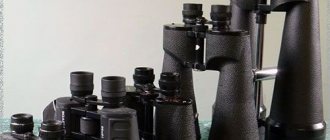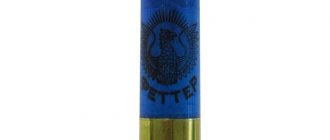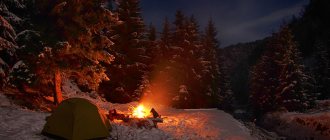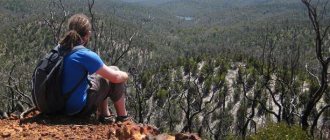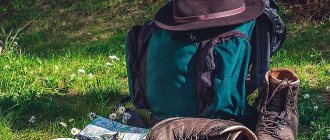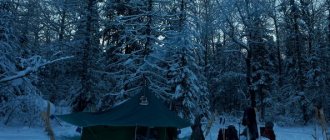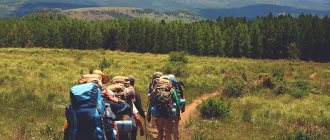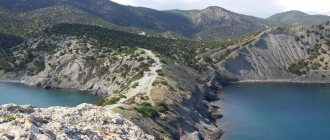If one day you suddenly want to spend your vacation not at a seaside resort, not sightseeing in world capitals, but in company with friends, or decide to take part in a mountain or hiking trip on your own, then you will definitely be faced with the question of organizing your own sleep. The choice of sleeping bag plays an important role here.
After reading this article, you will learn 10 factors that you simply need to know and consider when choosing a travel sleeping bag. It will be especially useful for beginner tourists. After all, one of the main problems for a beginner is the difficulty of choosing between dozens of models from different brands that fill the shelves of sports stores. Nobody wants to overpay for expensive models, which, perhaps, are excessive in quality for you. At the same time, you can simply not notice and pass by those sleeping bags that would be ideal for you.
In this article, you will learn everything you need to choose exactly the right tourist sleeping bag, the sleep in which will be as comfortable as possible, the packing volume and weight will be suitable for the conditions of your trip, and the price will correspond to the quality.
So, let's begin!
Factor No. 1. Temperature
Perhaps this is the first thing that any person choosing a sleeping bag pays attention to. And no wonder, because the correctly selected temperature regime of your sleeping bag is the key to a comfortable sleep.
To determine the temperature range at which a tourist will feel comfortable spending the night in a sleeping bag, many manufacturers test their products according to the regulations DIN EN ISO 23537 (formerly EN 13537). The essence of testing is that a special high-tech dummy is placed in a sleeping bag, dressed in a set of standard thermal underwear and socks. The mannequin is then heated to the temperature of a sleeping person (about 34˚C) and heat measurements are taken in various parts of the “body” for about half an hour. At the same time, factors such as the thickness of the mat under the mannequin, ambient temperature, its circulation and other important parameters are strictly regulated. An undoubted advantage of this testing is the ability to compare models of different brands, because research on sleeping bags is carried out in special independent laboratories and according to clear regulations adopted in 165 countries. However, due to its versatility, the test is not without its drawbacks. Thus, the heat generation of an average man, 25 years old, 173 centimeters tall and weighing 70 kilograms, and a woman of the same age, 160 centimeters tall and weighing 60 kilograms, is taken as a basis. It is clear that people of significantly less or, conversely, greater weight and height fit into this scheme with reservations. “Large” tourists generate more heat, and accordingly more heat is retained in the sleeping bag. With men and women of small height and weight, the opposite is true. The same applies to age, because it is known that heat exchange worsens over the years. In addition, the mannequin imitates the heat emission of a rested, well-fed person in dry clothes, and the sleeping bag itself is new and also, naturally, dry. The actual situation on a hike may be completely different.
But, despite all the shortcomings, the scale based on the test according to the DIN EN ISO 23537 standard (formerly EN 13537) is our only reliable assistant in determining the temperature conditions of sleeping bags.
What does a standard sleeping bag temperature scale look like?
Most often it consists of three, less often – four values. Let's look at them in more detail using the Deuter Orbit SQ - 5˚ sleeping bag as an example.
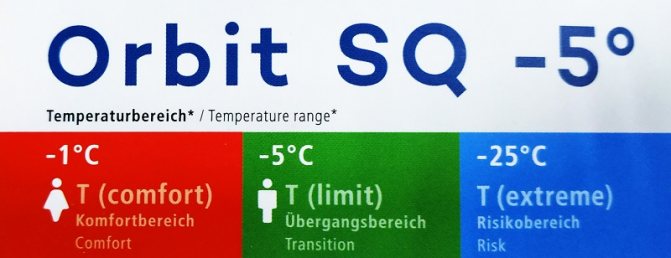
Tmax
The first and optional value for publication. As you can see, it is missing here. This is the upper limit air temperature at which a person can sleep peacefully in this sleeping bag. And this value is optional for publication because it does not affect security in any way. If a person gets hot, he will simply unzip the sleeping bag or even open it.
T comfort
Here and below are the values that are required for publication. In our case, it is 1˚C and denotes the ambient temperature at which a woman with the physiological parameters indicated above can sleep comfortably in a relaxed position (for example, on her back, with her legs stretched out) for at least 8 hours. Most women choosing a sleeping bag should focus on this value. Thin men of small stature should also focus on a temperature close to T comfort.
T limit
In our example, this is - 5˚ C. This value indicates the air temperature at which a man with the average parameters specified in the test conditions, lying in a heat-preserving position (for example, on his side, curled up) will sleep comfortably for at least 8 hours. Perhaps this is the most important value of all four, as it determines the safety limit of your sleep. It is important to know the approximate temperature conditions for future overnight stays, and you should definitely not buy a sleeping bag below the T limit value. If only one temperature value is indicated in the sleeping bag data, this is the limit temperature.
T extreme
This sleeping bag has a temperature of 25˚ C. This is the temperature at which a woman of the specified parameters can sleep in a heat preservation position for at least 6 hours.
At the same time, we are no longer talking about comfort. At this extreme temperature, only human survival is ensured with the accompanying risks of hypothermia, but without a serious threat to life. A person in a sleeping bag in temperature conditions close to T extreme will almost always be cold. It is also very important to remember that factors such as sleeping in wet clothes, on an empty stomach, after heavy physical activity and under stress greatly reduce resistance to cold. Accordingly, all the above temperature values in this case shift. Typically, manufacturers indicate the temperature scale both on the sleeping bag itself and on its packaging bag. It looks like this.
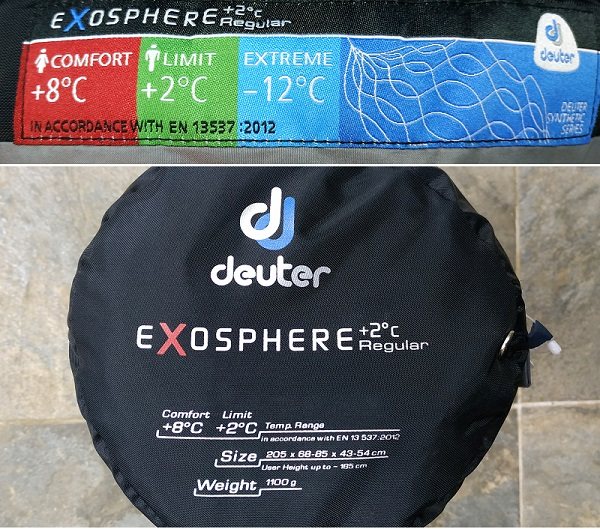
To summarize, I would like to note that the rules for choosing a sleeping bag based on temperature conditions are as follows.
It is highly advisable to know the temperature conditions under which you will sleep while camping. When choosing a sleeping bag, women should focus on the T comfort value. The same applies to men who do not tolerate cold well. For experienced tourists and athletes, as well as large people - at temperatures close to the T limit. T extreme values can be used as a rough guide only by very trained athletes, exclusively in combination with a full set of outerwear and literally for one or two nights, for example, subject to a sudden change in weather.
Best Camping Sleeping Bags
Outwell Campion Lux Red

A sleeping bag from the famous Danish brand Oase Outdoor, which has been developing products for family vacations for several years. The model is made of durable 190T polyester fabric, which has a lot of advantages - it practically does not wrinkle, is impregnated with a special moisture-proof compound, and is well ventilated. A double layer of isophyl was used as insulation, which has increased heat-saving qualities. It is thanks to him that this sleeping bag can be used comfortably even at -5 degrees, and its maximum is -15. The dimensions are designed for heights up to 195 cm, and the width is 85 cm. On the right there is a two-way zipper with a wide protective tape. There is a convenient pocket inside.
In tests, it showed excellent results in long-term use, during which the fabric was not damaged, the filler did not get lost, and the fittings did not deteriorate. It withstood the temperature test, showing itself on the positive side even at -8 degrees below zero.
The price for this sleeping bag varies from 3800 to 5000 rubles.
Seagull Dream 300
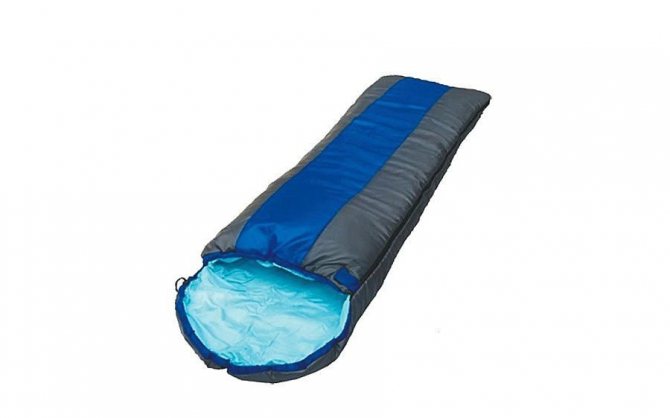
A sleeping blanket with a headrest for adults from the Russian sewing holding Chaika is designed for comfortable sleep at temperatures from +10 to +3. It is not recommended to use at zero or minus readings - there is a risk of hypothermia.
The outside of the bag is made of polyester silk impregnated with a water-repellent composition, which is quite durable to use. The inner material is pongee with a mixture of cotton, quite pleasant to the body. The filling is thermofiber, evenly distributed throughout the sleeping bag. It is characterized by high heat-saving properties, the ability to allow air to pass through and not absorb moisture. The zipper is located on the right side of the body, the headrest is fixed with ties to the desired size. The length and width of the bed is 190*75 cm.
The owners of this tourist bag note the high-quality tailoring, as well as excellent warming characteristics at positive temperatures and an extremely favorable price - from 1,200 rubles.
The only disadvantages include the helplessness of a sleeping bag at 0 degrees and below, but the manufacturer also warns about this.
GreenWood RS FS-1008
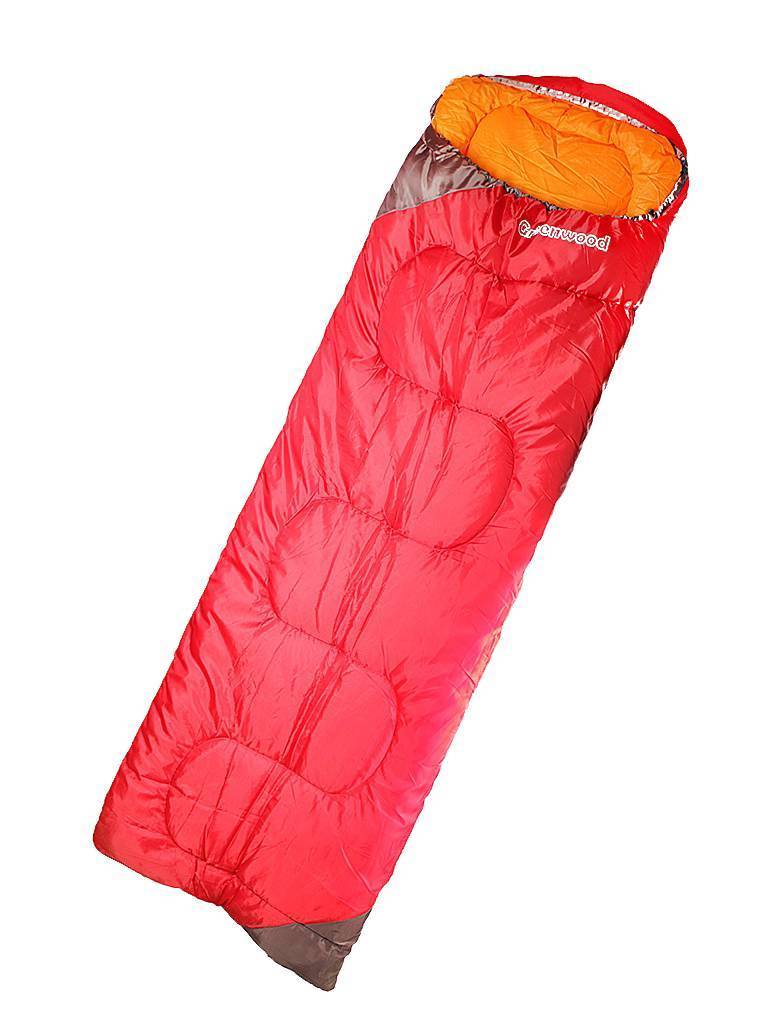
A universal sleeping bag with a hood made of high-quality polyester with synthetic filling. It can only be used in summer, since its maximum temperature is +8 degrees; at lower temperatures it is not capable of warming its owner. The kit includes a carrying case. When unfolded, it measures 75*75*190 cm. The zipper is located on the right edge and opens only from the outside. For greater convenience, you can fasten a second bag or open the sleeping bag completely, getting a full blanket.
Reviews differ in opinion, but unanimously note poor cold resistance and even discomfort was noticed at above-zero temperatures. Also, the disadvantages include the difficulty in lining two bags. But there are also advantages - softness, comfort, pleasant internal material, good price - from 1100 rubles.
TREK PLANET Avola Comfort
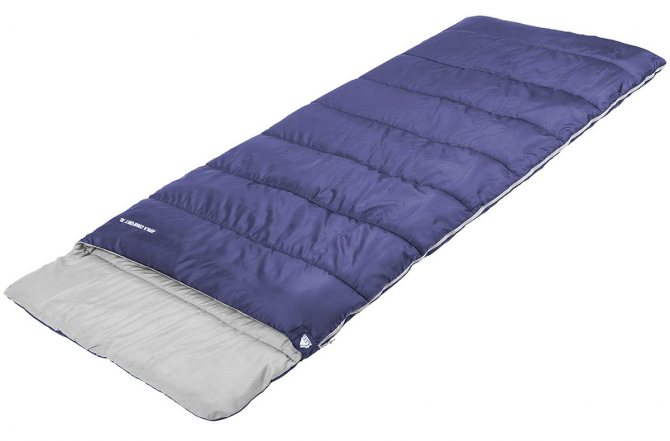
Representative of a Russian brand that recently appeared on the market. The sleeping bag is made of polyester with holofiber insulation. Ideal for summer hikes in nature, relaxing on the river bank or in the country. It heats well at a temperature of +5, the extreme limit for use is -5 degrees.
The sleeping bag has a comfortable width of 85 cm, and its length is designed for a maximum of 1.95 m. There is a zipper with a windproof valve on the left side, and there is a wide hood to protect the head.
Buyers note both pros and cons in this model. Among the advantages are the low price, starting from 1,750 rubles, spaciousness and warmth. But there are more disadvantages:
- the filler rolls off during use;
- the seams are stitched through and the needle holes are visible to the naked eye;
- after several uses, a deterioration in temperature properties is noticed;
- The upper material is thin, and puffs appear quickly.
Alexika Mountain Baby
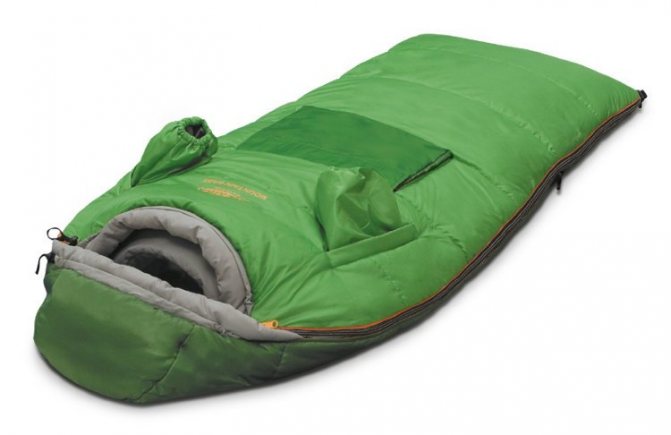
A children's sleeping bag from an American brand is intended for use only in the warm season. The optimal temperature at which it will be able to warm the child is +10, and the lower value is 0 degrees. Internal and external material: high-quality polyester. Additionally, there is a snap-on cotton liner, which is more pleasant to the body and protects the bag from dirt.
When assembled, it is quite compact - 35*25*21 cm, packed in a protective case with wide handles. When unfolded, it measures 65*55*130 cm; it is possible to adjust the length of the sleeping bag to suit the child’s height using straps. The main feature is the sleeves with elastic, thanks to which the baby can play with toys or read before bedtime. When not needed, the sleeves are tucked in and fastened with a zipper, and tired dolls and teddy bears can be easily stored in the wide pocket of the sleeping bag.
A two-way zipper is located on the sides and, if desired, you can easily turn the bag into a blanket. The slider has a backlit loop that glows brightly in the dark.
The child's head is protected by a deep hood, and a wide strip is sewn inside the front of the bag to protect the throat. Another feature of the Alexika Mountain Baby is the ability to unzip the sleeping bag only from the bottom, which allows you to use it as a long jacket.
The price of a sleeping bag is quite affordable for such high quality - from 6,000 rubles.
Factor No. 2. Sleeping bag shape
Tourist sleeping bags are divided into cocoons and blankets according to their shape.
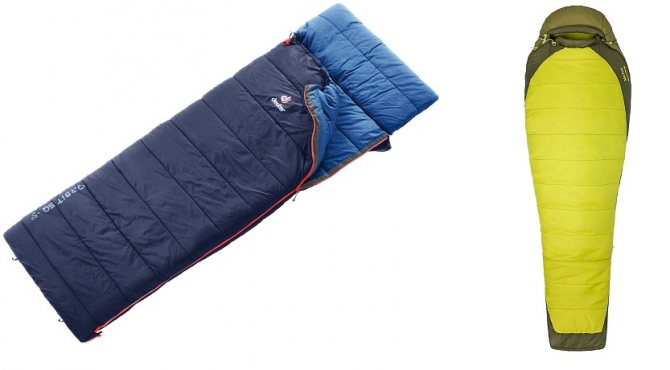
Initially, all sleeping bags were made in the form of a blanket. The advantages of this design are its simplicity and large space inside for changing body position while sleeping. This type of sleeping bag can be completely unzipped and used as a regular blanket in case of, for example, hot weather.
Cocoon sleeping bags, due to their narrowed anatomical design, save weight and space in a backpack. All other things being equal, they are warmer than their fellow blankets, because they have practically no extra unheated zones inside. The problem of small internal space is solved by some manufacturers by using elastic materials and seams. The sleeping bag stretches in all directions, giving the owner freedom of movement. This is, for example, the Deuter Exosphere sleeping bag.

To summarize, cocoon sleeping bags are more suitable for a hiking trip or mountaineering due to their lower weight, packing volume and better relative warmth.
The advantage of blanket sleeping bags in the larger internal space will be relevant in camping tourism, road trips and simple weekend hikes in the warm season, that is, when the weight and volume of the sleeping bag are not so important.
Here we move smoothly to our third factor.
Sleeping bag: temperature indicators
In a sleeping bag, its temperature indicators are important, the range of which must correspond to the climatic conditions of the area where it will be used. As a rule, 3 temperature indicators are indicated on the sleeping bag. These are the so-called indicators of maximum, comfortable and extreme temperatures.
Men generate more heat than women, so women need warmer sleeping bags. The temperature minimum for a woman is 5°C higher than for a man.
Maximum temperature – shows the temperature at which, even with the sleeping bag unzipped, you can rest and sleep.
Comfort temperature – in these conditions the sleeping bag will be warm and comfortable.
Extreme Temperature – At these temperatures, additional clothing and mats may be required depending on sensitivity to cold and environmental conditions. The extreme temperature indicator indicates at what temperature a person, being in a fully zipped sleeping bag, will not die from hypothermia.

The average woman can sleep comfortably in this sleeping bag at air temperatures from +22°C to +4°C, and the average man - at temperatures from +22°C to -1°C. The sleeping bag must retain enough heat to prevent hypothermia (hypothermia) at temperatures down to -18°C. But at temperatures from -1°C to -18°C there is already a health risk.
What sleeping bag is appropriate for the season?
Depending on the season of use, sleeping bags can be divided into three groups:
– Three-season sleeping bags (early spring, summer, autumn) ... -2 ... -5 degrees. This means that a comfortable temperature for using a sleeping bag will be up to – 5 degrees, but in unfavorable weather conditions you will not freeze even at minus 12 – 15 degrees.
– Summer sleeping bags ...0...+5 degrees. This is quite enough for a comfortable stay.
– Winter sleeping bags …- 10…- 25 degrees – but this is more suitable for professionals.
Factor No. 3. Weight and packing volume of the sleeping bag
The rule for choosing sleeping bags based on this parameter is simple: the smaller the weight and volume of the sleeping bag at the same temperature as other temperatures, the more expensive it is. Global manufacturers are struggling with the task of reducing the weight of a sleeping bag while maintaining high heat-saving properties. Champions in light weight and volume are down sleeping bags. Due to the natural properties of down to greatly decrease in volume when compressed, such sleeping bags take up less space in a backpack. And the lightness of the down ensures low weight. Thus, the Marmot Sawtooth sleeping bag with a temperature limit of - 9˚C weighs only 1.22 kg.
And in the Deuter Astro Pro 800 winter sleeping bag weighing 1.5 kg you will be comfortable down to - 15˚C.
The best three-season sleeping bags
ECOS Sanford - stretch
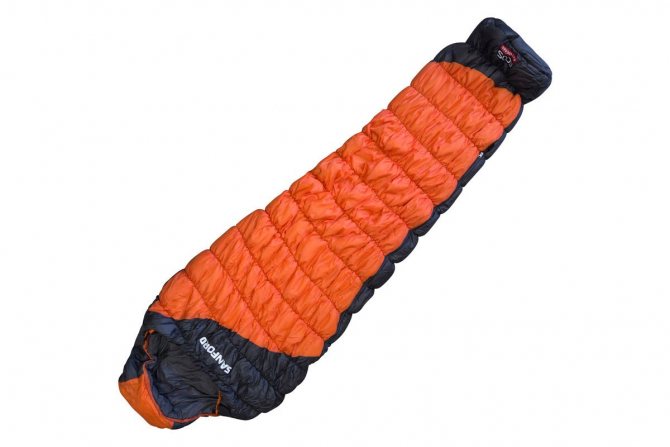
The ECOS Sanford sleeping bag has an unusual cocoon shape with stitched seams, thanks to which the fabric gently hugs the body without pinching or creating extra space. At the same time, in a zipped sleeping bag, it is convenient to turn from side to side and sit down. The sleeping place is large 220*90*60 cm, so even a tall and large person will be comfortable in it.
The top layer is made of durable ripstop material that can withstand prolonged use in harsh conditions with dignity. The inner material is soft microfiber with a high thread density. As for the filler, it is artificial down - it is warmer than natural, does not pill, does not cause allergies, and is easy to wash.
ECOS Sanford is designed for use at temperatures from 0 and above, the minimum permissible value is -15. In testing I was able to withstand -5 degrees without using thermal underwear; at -10 the need for light insulation was recorded.
Users respond positively to both short-term and long-term use of this sleeping bag model. The price is about 4000-5000 rubles.
PRIVAL Stepnoy XL KMF
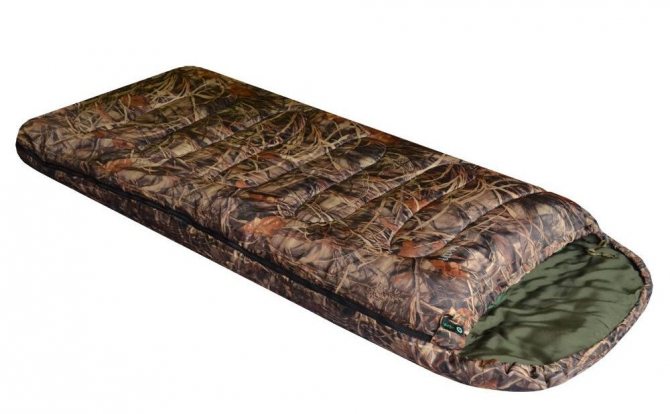
A sleeping bag from a Russian manufacturer with excellent dimensions of 220*95 cm will please most extreme tourism lovers with its characteristics:
- does not retain moisture;
- very warm, thanks to environmentally friendly fiberplast insulation;
- soft;
- comfortable inner material with a high percentage of cotton;
- made of high-strength cushion material, which provides maximum protection from moisture and wind;
- can be used as a blanket.
Double zippers are located on both sides, equipped with protective strips against fabric chewing, and are additionally secured at the top with Velcro. The headrest is wide and soft. The bag can easily withstand temperature loads down to -2-3 degrees, the maximum being -7-9.
The owners fully confirm all the characteristics described above, especially highlighting the convenience and maximum comfort while sleeping, the strength of the outer fabric and the low price from 2900 rubles. Of the minuses, only the clasp of two sleeping bags is mentioned.
TREK PLANET Track 300
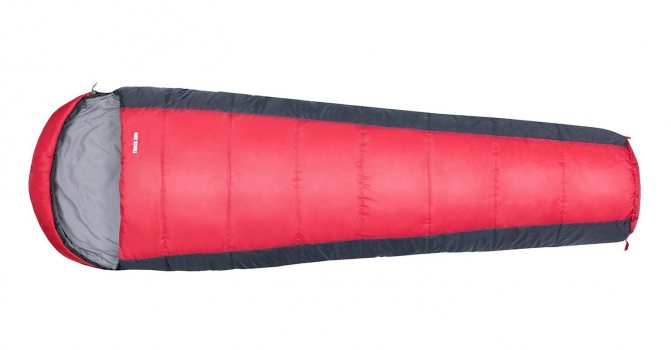
This sleeping bag is declared by the manufacturer as a three-season one, but it is worth considering that the officially established temperature limit is only 0 degrees. You can use it even at -13, but at least wear thermal underwear.
The sleeping place is 230 cm long with a hood, but there is a nuance - the shape in the form of an elongated trapezoid does not allow you to sit comfortably and turn around inside. Reviews from the owners of this model unanimously state that the legs are uncomfortable and there is a feeling of tightness. At the top of the bag the size reaches 85 cm, at the bottom - 55 cm.
Double zippers are located on both sides of the bag, equipped with windproof strips, and there is a small pocket inside. The hood is conveniently adjustable with laces. External and internal material: polyester. Holofiber insulation with a density of 300 g per sq.m.
Owners of TREK PLANET Track 300 rightly note the strength of the outer fabric, comfortable zippers and a deep hood, the presence of a collar, and the uniform placement of insulation.
But there were also disadvantages:
- at +5-7 degrees it is cool in the sleeping bag;
- uncomfortable shape;
- sloppy seams;
- large weight and volume when folded - 27*27*39 and 1.9 kg;
- lack of compression bag.
This model can be purchased at a price of 2000 rubles.
Factor No. 4. Insulation material
Depending on the type of insulation, sleeping bags are divided into down and synthetic. In the first case, mixtures of down and feathers of waterfowl (most often geese) are used. The ratio of down and feathers in such mixtures can vary quite a lot. The more fluff, the better and more expensive the mixture. The best performance is found in a mixture with a ratio of 95 percent fluff to 5 percent feather. In the characteristics of a sleeping bag, this parameter is usually written as a fraction, for example, for the indicated ratio - 95/5.
Another parameter of down insulation directly related to thermal properties is Fill Power. This is the ability of fluff to restore its original volume after compression. The higher this indicator, the better the quality of the fluff. Designated by different manufacturers as Fill Power, Fill Down, FP or Cuin (cubic inch). For natural down, Fill Power values of 650 and above are considered good.
So, for example, in the Salewa Flare -4 sleeping bag, the Fill Power indicator is 700+, and the ratio of down and feathers in the mixture is 90/10, which allows it to show a T limit of - 4˚C with low weight and volume.
The following are the main synthetic insulation materials:
Hollowfiber produced by Moscow
This is a non-woven synthetic fabric made of hollow spiral fibers. Due to its shape, many air cavities are formed inside this insulation, preventing heat migration. The material does not absorb moisture, does not retain odors, does not accumulate dust, and therefore is hypoallergenic. Holofiber threads twisted into a spiral make it elastic and easily restores its shape after deformation. It is produced by the thermal adhesive-free soldering method, when pre-treated fibers are firmly connected to each other under the influence of high temperature. This allows us to minimize the content of chemical compounds that are potentially aggressive to humans and makes the material environmentally friendly. It does not rot, is not affected by mold and other microorganisms. Holofiber is used in construction (as insulation and sound insulation sheets) and in furniture (filling material). Due to its safety, it is used in the manufacture of soft children's toys. And its elasticity, relative cheapness and good thermal insulation make the material attractive in the production of blankets, pillows, mattresses, winter outerwear and, of course, tourist sleeping bags.
Many brands, including foreign ones, use holofiber or its analogues as insulation in their products. For example, in the Space family of sleeping bags from the German company Deuter and in the Orbit SQ sleeping bags from the same manufacturer. Budget-friendly, environmentally friendly, resistant to washing and mechanical stress, holofiber is ideally suited as insulation in comfortable and spacious sleeping bags-blankets for simple tourism and outdoor recreation.
-30%
Sleeping bag Deuter space i right titan-black
4 053 5 790
athlete price
Sleeping bag Deuter 2020 orbit sq -5 left navy/steel
11 790
The good thermal insulation properties of holofiber make it possible to use this material in sleeping bags for low temperatures. For example, in the Red Fox Explorer sleeping bag -30C, with a temperature scale of T comfort – 1.3˚ C, T limit – 7.4˚ C, T extreme – 25.5˚ C.
Primaloft from the American company of the same name
This synthetic material was originally developed for the needs of the army, and only later entered the civilian market. The company offers a whole family of insulation materials with different properties. Sleeping bags mainly use Primaloft in the form of synthetic down, similar in structure to natural down. Unlike the latter, this insulation does not absorb water. Its microfibers are treated with silicone. Primaloft retains heat well inside the sleeping bag and is not afraid of getting wet.
All these qualities have ensured the successful use of Primaloft insulation in sleeping bags designed for use in harsh conditions in areas with high humidity. To a certain extent, this insulation forgives not very careful handling. As an example, the Red Fox X-Light sleeping bag, designed for adventure racing, active hiking and traveling.
In addition to the above brands, many companies produce their own synthetic insulation materials. These are, for example, Thermo Pro Loft from the German Deuter, Spirafil and Heatseeker from the American Marmot and The North Face, respectively. They are close in their functional qualities to products made from holofiber and Primaloft and are successfully used in tourism, mountaineering and other types of outdoor activities. Many companies are striving to improve the environmental friendliness of their production. For example, Heatseeker insulation in the Eco variety consists of almost a third of recycled materials.
-30%
Sleeping bag Deuter exosphere -4 – sl left fire/cranberry
8 043 11 490
-30%
Sleeping bag Marmot nanowave 35 moss
6 083 8 690
athlete price
Sleeping bag The North Face cat's meow guide reg blue wing teal/zinc gray
15 695
Buy
The main advantage of synthetic sleeping bags is their relatively low price and the fact that even when wet they continue to retain heat quite effectively. Natural down, when wet, loses almost all of its heat-insulating properties. True, many manufacturers now treat down with a special water-repellent composition to protect down from moisture and thereby practically nullify the advantage of synthetic insulation. And for additional protection of the sleeping bag from moisture, modern shell materials are used that prevent getting wet, as well as dirt- and water-repellent impregnations.
The advantages and disadvantages of down and synthetic sleeping bags are described in more detail in our article.
Article: Down or synthetic, and other important issues when choosing a sleeping bag
Insulation used in sleeping bags
Modern sleeping bags can be filled with natural down or synthetic filling.
Thanks to the rapid development of technological materials, synthetics have come close in their properties to high-quality goose down, but still cannot catch up with the best quality down in terms of thermal insulation properties, plus, as a rule, it has greater weight and volume when packaged. However, most synthetics have an important advantage - they retain their thermal insulation properties (continue to warm) even when wet and dry faster than down.
Pooh
Lightweight filler with excellent thermal insulation and compression properties (warms well, compresses compactly), but the disadvantage is the fear of moisture. Although modern manufacturers are increasingly using hydrophobic down, treated with special impregnations and having moisture-repellent properties. These can be found, for example, from Montbell and Brooks-Range. In addition, sleeping bags may use a moisture-resistant outer fabric or membrane that will protect the down from getting wet.
High-quality down will cost more than synthetics. The main indicator of down quality is determined using the Fill Power indicator. This is the ability of insulation to expand after loading. For example, a sleeping bag was in a compression bag in a backpack while traveling along the route, and in the evening you took it out for an overnight stay. The higher the Fill Power indicator, the more efficiently the fluff opens and fills the volume and the higher quality it is considered. As a rule, equipment uses down with an FP value of at least 550, and the highest values reach 800-900 and even 1000 units and are used in top models.
The photo below shows what structure fluff has with different FP values and how the same amount of fluff (85 grams) with different FP values takes up different volumes in a measuring cup.
Photo: www.montbell.us
Due to thermal insulation, low weight and good compressibility, down sleeping bags are preferable for winter and high-altitude ascents, as well as hikes and expeditions at the lowest temperatures.
Synthetic fillers
Unlike down, modern high-tech synthetics do not lose their thermal insulation properties even when wet, they dry faster and in most cases are cheaper, but, as a rule, they weigh more, take up more volume when packed and cake faster. Weight and compression properties depend on the specific type of synthetics. The most common insulation materials found in sleeping bags from leading manufacturers: Thihsulate, Thermolite, Primaloft, Heatseeker and Climashield.
Synthetics can be preferred if you are choosing a three-season sleeping bag, planning a trip to a region with high humidity or a hike with possible temperature changes.
Factor No. 5. Dimensions
The general rule for selecting a sleeping bag by size is a person’s height plus 20-30 cm. Moreover, for summer models a margin of 15-20 cm is sufficient, and for winter sleeping bags – 25-30 cm. This is due to the fact that, as a rule, During the warm season, tourists sleep only in a set of thin thermal underwear, and for overnight stays in sub-zero temperatures, additional insulation may be required in the form of thick fleece or a down jacket, a hat and socks. In addition, often in winter tourists put a bottle of water with them in their sleeping bag (so as not to freeze), a camera, a phone, batteries, liners from mountaineering boots and a set of running thermal underwear so as not to climb into cold clothes in the morning. For all this, a sleeping bag needs additional internal space.
For the convenience of tourists, some manufacturers produce sleeping bags in two sizes: R (regular) - for people up to 185 cm tall and L (long) - for people taller. This can serve as a rough guide when choosing a sleeping bag, with the caveat that if your height is only slightly below 185 cm, then it is better to buy a sleeping bag in size L. Sometimes there are also sleeping bags in sizes EL (extra long) - for very tall people.
There are also special women's models. They are designated by the abbreviation SL on the packaging. Women's sleeping bags are smaller than those for men. On average, they are designed for women up to 175 cm tall and are better insulated. A good example of this type of sleeping bag is the Deuter Astro Pro 600 SL.
It is worth noting that for short men, choosing a sleeping bag in size SL will be justified. You will not carry extra weight on yourself, as is the case with a standard size R (regular) sleeping bag. And due to the higher density of the insulation filling, the sleeping bag will warm better.
In any case, it makes sense to climb into a sleeping bag before purchasing, zip it up and try to lie in it, turn around, feel its internal volume and evaluate its ease of use. All this can be done in any of our stores.
Where can I buy
Friends, are you determined to acquire an indispensable travel attribute? Then you should look into specialized retail outlets. Various sports and outdoor equipment stores offer a wide selection of sleeping bags. But do not forget that their prices are usually not cheap. In addition, it is not a fact that the required size of the sleeping bag you like will be available.
What to do in this case? I boldly advise you to order the things you need from reputable online stores:
- My-shop.ru
- Ozon.ru
- AliExpress
With their help you will save your time and money. In addition, the presented assortment will be much larger than in a regular store in your city.
Do not forget to carefully compare your parameters with the manufacturer’s sizing chart before purchasing. Also pay attention to the ratings and reviews of the product and the seller.
Enjoy the shopping!
Factor No. 6. The role of the rug
The excellent heat-saving qualities of any, even the best sleeping bag, can be negated by the wrong selection of a rug for it. When spending the night in a tent, the main cold comes directly from below, from the cooled ground. The insulation at the bottom of the sleeping bag naturally wrinkles, reducing thermal insulation. Therefore, when choosing the “best” sleeping bag, do not forget about a suitable rug. A properly selected sleeping bag and mat are the basis of the so-called “sleeping system”, which ensures the comfort and safety of its user.
Our stores offer mats for a wide range of temperatures and conditions of use, from simple polyethylene foam (“foam”) and closed-cell EVA to compact packaging and comfortable self-inflating ones.
Travel mat Nova Tour tourist 8mm (two-layer PPE)
630
Buy
-40%
Travel mat Salewa accessories eva-foam mat anthracite /
1 494 2 490
Travel mat THERM-A-REST ridgerest solite large silver/sage
4 250
Mat Self-inflating THERM-A-REST women's trail pro mint
10 400
athlete price
Self-inflating mat Salewa mat comfort applegreen/grey
7 490
What material should I buy the bag from?
One of the main quality indicators of any type of sleeping bag is the filler. There are artificial and natural insulation materials.
Pooh
Down is the warmest and most expensive filling for both sleeping bags and winter outerwear. Its undoubted advantages include its lightness, excellent thermal insulation and elasticity (it compresses, but does not cake). For better insulation, the bags are filled with the down of waterfowl. Eider down is the most expensive. And in order to prevent the fluff inside from clumping, they also add a goose feather, but not more than 20% of the total volume.
Silicone
There are less expensive fillers that are not inferior in their thermal insulation properties. For example, silicone. The ability to retain heat depends on the thickness of the fibers and their density. In addition, silicone does not get wet and is more durable to use due to the fact that it does not cake if you follow all the rules for caring for it.
Sintepon
The most budget material is padding polyester. Suitable for those who prefer rare outings to regular expeditions. The plus is that it dries quickly, the minus is that after 2 years it becomes unusable.
In addition to the “insides” of the sleeping bag, when purchasing, consider what fabric it is made of. Most camping gear is now made from synthetic materials. The lining should preferably be made of natural cotton, but nowadays there are more inexpensive substitutes that have hypoallergenic properties and are no less pleasant to the body than cotton options.
0
Author of the publication
offline 2 years
Nika
7
I am interested in hiking and traveling, photography and videography. I have been going hiking since childhood. The whole family went and went - sometimes to the sea, then to the river, to the lake, to the forest. There was a time when we spent a whole month in the forest. We lived in tents and cooked over fires. This is probably why I am still drawn to the forest and, in general, to nature. I travel regularly. About three trips a year for 10-15 days and many 2 and 3 day hikes.
Comments: 0Publications: 668Registration: 10/23/2018
Nika's Shelter
Factor #7. How to pack
To further reduce the packing volume of sleeping bags, tourists use compression bags with special drawstrings. Almost all sleeping bags are sold in them. These bags can also be purchased separately.
Compression bag Red Fox small red
1 100
athlete price
Compression bag Salewa sb compression stuffsack l yellow
1 290
Buy
It is worth noting that any sleeping bags should be stored unfolded outside of a camping trip, so that the insulation does not cake and lose its useful properties. Often the sleeping bag already includes a special bag for storing it.
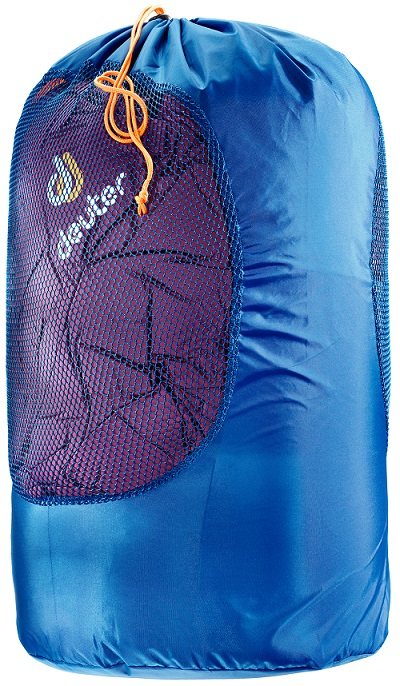
When carried in a backpack, the sleeping bag is usually located at the very bottom for optimal weight distribution.
Form
The choice of shape is always a compromise between size and convenience. There are four main types of products.
- Blanket
It has the shape of a rectangle with equal width at the shoulders and head. The zipper opens completely, and you get a full-fledged blanket. Being in such a bed is comfortable and pleasant, because nothing hinders your movement. However, it is more suitable for road trips, since it takes up a significant amount of space and weighs a lot.
- Cocoon
Another name for this is “mummy”. The main difference is the maximum repetition of the outlines of the human body. The sleeping bag is wide at the shoulders and narrowed at the bottom. Thanks to this, it weighs less and is more compact when folded. The absence of empty space inside allows you to warm up faster, but at the same time creates difficulties when turning over. In other words, such a bag can be cramped.
- Quilt
Due to its structure, it is used exclusively in tandem with a good travel rug. Such samples do not have a clasp and there is no protection on the back. The logic is simple: during use, the filler on the back is crushed and does not serve as thermal insulation. The mat has to take it over. This means that it is permissible to remove the excess to lighten the luggage.
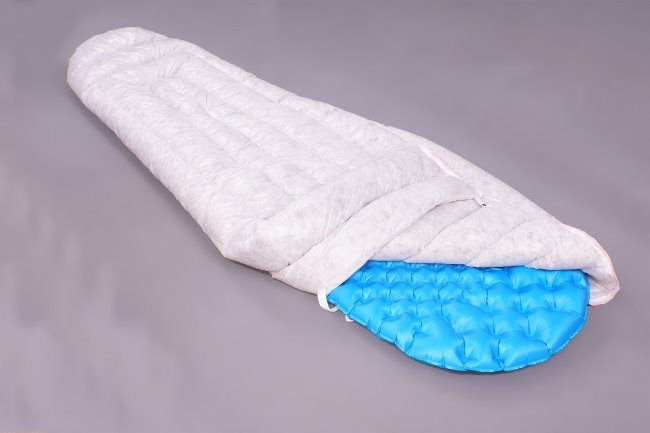
The solution also has disadvantages: heat loss at the junction of the bedding and sleeping bag, inconvenience of sleeping on the side, difficulty getting inside.
This variant has not yet become widespread in our country, but is often found in America.
- elephant foot
Short cocoon: its length reaches to the waist or armpits. It is mainly used in difficult winter hikes, where every gram counts. Tourists still have a very warm down jacket at their disposal, in which they are invited to sleep.
Factor No. 8. Pleasant little things
An insert will be a pleasant and useful addition to a sleeping bag. Thanks to him, the sleeping bag does not get so dirty and is saturated with odors from the inside. Washing the liner is much easier and faster. And the less you wash your sleeping bag, the longer it retains its heat-insulating properties. Many earbuds are additionally treated with silver ions, which gives them antibacterial properties. In hot weather or in a warm room, you can sleep in it alone.
These are, for example, the sleeping bag inserts Salewa 2020 Liners and Pillows and SeaToSummit Silk Stretch
-40%
Sleeping bag insert Salewa liners and pillows microfibre liner silverized gray /
2 490 4 150
-40%
Sleeping bag liner Sea To Summit silk stretch liner-mummy navy blue
3 276 5 460
A lightweight, breathable liner is a good option for traveling, for example, in India or the countries of Southeast Asia, with their unique ideas about cleanliness in hostels and hotels.
For those who like comfort on light hikes and car camping, a lightweight pillow such as THERM-A-REST Compressible Pillow may be useful.
Those who want to travel with their other half will find it interesting to link sleeping bags together. To do this, when choosing a sleeping bag, you need to pay attention to the location of the zippers. They should be on different sides of the sleeping bags. Sleeping together in such a quilted design is much more comfortable and warmer than sleeping alone.
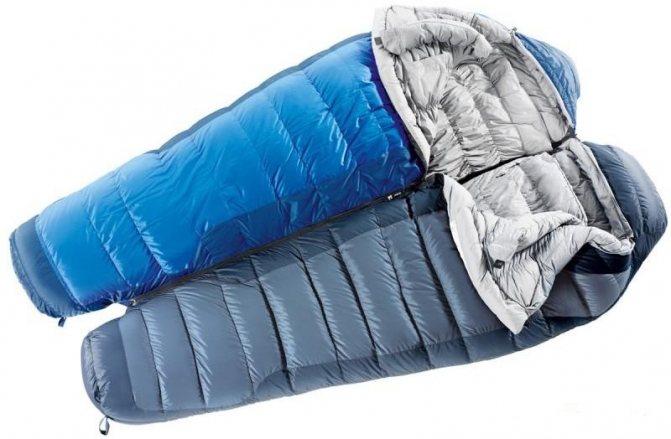
Speaking about protecting a sleeping bag, especially a down one, from moisture, it’s worth saying a few words about waterproof bags. A good solution to keeping your sleeping bag dry is to place it in a waterproof cover. You can also put a set of thermal underwear for sleeping there. The hermetic bag guarantees you sleep in a dry sleeping bag and linen, no matter what challenges you face during the hike.
Some manufacturers take a particularly responsible approach to the issue of night comfort and think through a whole system of useful and pleasant little things in their sleeping bags. Here is an incomplete set of such technical “chips” that Deuter uses in different models of sleeping bags.
- Contoured, comfortable hood with two cords for a precise fit to your head.
- Velcro pad to prevent spontaneous unfastening of the zipper.
- Collar for added warmth with Velcro or built-in drawstring.
- Warming inserts made of soft fleece.
- Internal zip pocket for flashlight, phone and other small items.
- Anti-zipper tape.
- Insulating strip along the zipper, preventing heat loss.
- Technology for denser insulation filling in the ankles and legs.
How to choose a sleeping bag for hiking and fishing
When going fishing or on a hike that is not associated with extreme types of recreation, you first of all count on a comfortable pastime away from civilization. For avid fishermen and novice travelers, the best option would be a blanket sleeping bag model. It will be able to provide a comfortable rest in nature (Figure 6).
However, there are several other criteria that need to be taken into account:
- When choosing temperature conditions and filler material, you should focus on the area and time of year.
- You also need to consider the possibility of morning humidity and precipitation.
- If you are going fishing, hiking in fairly dry areas, or planning to live in a campsite where you can shelter from the rain at any time, then you should pay attention to down fillings.
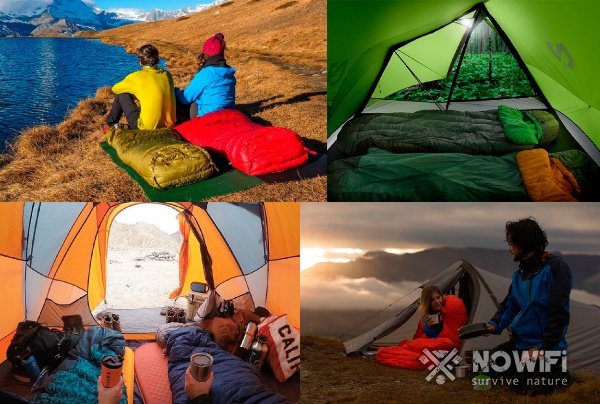
Modern technologies of external moisture-proof coatings are sufficient to ensure that the sleeping place does not get wet under short-term precipitation and continues to provide warmth and comfort, even far from home.
Factor No. 9. Sleeping bags for children
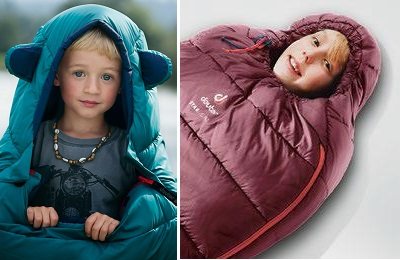
A special type of sleeping bags is children's. They are not tested for thermal insulation, so they are not labeled with a temperature range. Most often, such sleeping bags are designed only for positive temperatures. Ultimately, the decision about the necessary properties of a sleeping bag lies with the parents, who better know the characteristics of their child.
A pleasant (primarily for the parent’s wallet) feature of some children’s sleeping bags is the ability to extend them. For example, the Deuter Little Star EXP sleeping bag has a special zipper at the bottom, unzipping which you can increase the length of the bag from 115 to 145 cm. The Deuter Starlight sleeping bag has the same extension function. If additional length is not needed, then the child’s legs will simply be even better insulated.
athlete price
Sleeping bag Deuter little star exp left papaya-lava
4 390
athlete price
Sleeping bag Deuter 2020 starlight left maron/navy
7 490
Buy
athlete price
Children's Sleeping Bag Salewa maxidream sb right davos
5 690
Buy
-30%
athlete price
Children's Sleeping Bag Marmot kid's trestles 30 left lipstick
7 343 10 490
Mandatory little things
The sore spot of any sleeping bag is the zipper. It quickly breaks down due to frequent and careless use. Be sure to check the strength and comfort of the fastener. It is better if it is quite large, with fastening from the inside and outside.
The sewn-on insulated tape prevents the snake from biting the fabric and prevents cold air from penetrating inside.
Some sleeping bags are allowed to be zipped together. It turns out to be a bed for two or even three tourists. To have this opportunity, take copies with zippers located on different sides: on one bag on the right (R), and on the other on the left (L). Please note that models with a clasp located in the center cannot be connected.
What other design features are useful:
- An additional collar with a layer of insulation and drawstring helps keep the head and neck warm.
- Pocket for a pillow – instead of a full pillow, you can put soft clothes inside.
- Internal compartment for phone and documents.
- Insulated inserts - found in the back, feet and ankles.
- Hanging loop - useful when you decide to dry your bed.
- Non-slip elements on the bottom prevent it from rolling off the mat. So far, such an addition is rarely used.
As for color, the requirements here are similar to those that apply when choosing a tent. If you want to go unnoticed, then take neutral colors: black, green, blue. On an extreme expedition, it is worth choosing a bright object: orange, red, yellow.
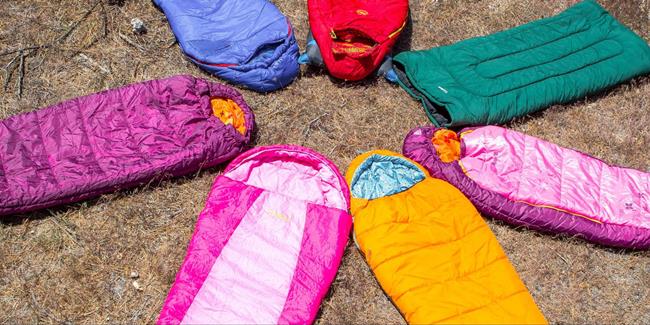
Keep in mind that a brightly colored specimen is easier to find if it suddenly gets carried away. And dark fabrics heat up in the sun and dry faster.
It is best to pack a sleeping bag in a compression cover. In some models it is included, but in others you will have to buy it additionally. Thanks to the tie straps, the volume of the product is reduced to the maximum possible.
Please note that this option is only applicable for hiking. At home, equipment should be stored flat or in a loose case. The insulation will not cake, and the sleeping bag will last longer.
You can keep your bedding dry during treks, even in pouring rain, if you put it in a hermetic bag. Hide a set of underwear there, and it will not get wet, even if the rest of your clothes are saturated with moisture.
Factor No. 10. A little about winter sleeping bags
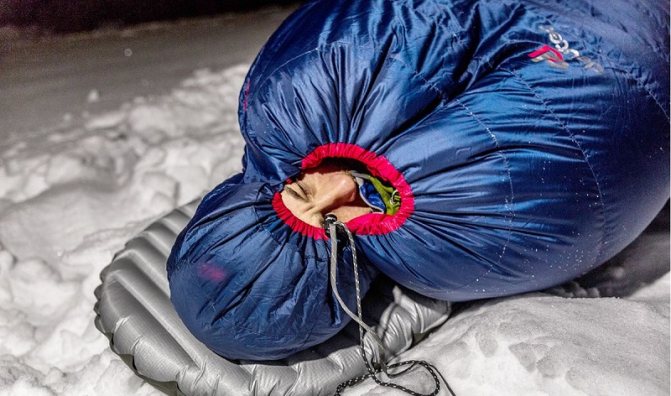
A separate big topic is sleeping bags for winter hikes, polar expeditions and high-altitude mountaineering. Here, of course, the ability of such sleeping bags to keep warm at extremely low temperatures comes to the fore. According to the regulation DIN EN ISO 23537 (formerly EN 13537), testing of sleeping bags for use in areas where the temperature drops below - 20˚ C is not possible. It is assumed that people planning to sleep in such difficult conditions will use a combination of rugs, sleeping bags, additional insulation products, and perhaps take care of heating the tent, so it is not possible to simulate the real operating conditions of a sleeping bag taking into account all factors. Companies that produce such sleeping bags test them themselves and indicate approximate temperature conditions for use.
In the vast majority of cases, the insulation materials are natural fluff; the shape is cocoon-like. Winter sleeping bags are distinguished by high technology materials and design, as well as a rather high price. And it’s not surprising, because here we are talking not only about comfort, but also about survival.
Best extreme sleeping bags
RedFox Yeti -20
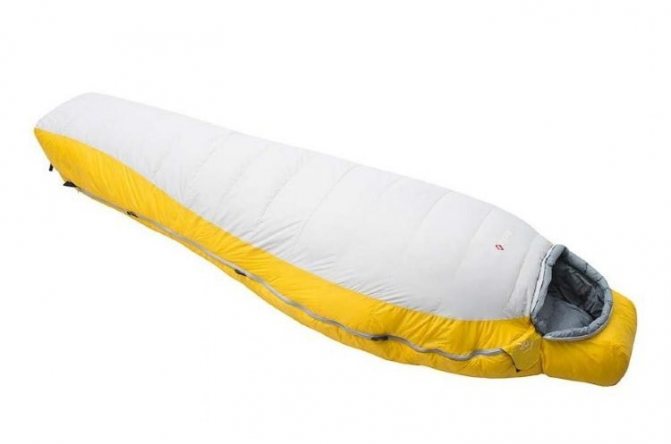
The Red Fox brand has had a high trust rating among customers for 30 years. It is valued for the quality of tailoring, thoughtful design and the use of only the finest materials in production.
The Yeti -20 sleeping bag is made of 30 denier nylon on the outside and nylon on the inside, only thinner and softer. The filling is natural goose down, which gives enough warmth, does not weigh down, does not pill, quickly restores its shape after pressing and lasts a long time.
The bag is made in the shape of a cocoon with a narrowed bottom. You can choose from a left-sided double zipper or a right-sided one. The slider moves smoothly without delay, and has a glow-in-the-dark clip at the end. The hood is deep, tightly covers almost the entire face and is adjustable with laces. There are two sizes on sale - regular 2.03 * 0.81 m and large 2.13 * 0.83 m. When folded, the sleeping bag weighs only 1.4 kg and has compact dimensions of 36 * 23 * 19 cm. Comfortable temperature conditions limited to -7 degrees with a maximum of -25.
Reviews characterize this model very positively:
- comfortable shape;
- light weight;
- high-quality tailoring and accessories;
- "breathable" materials;
- ability to withstand up to -8-9 degrees without additional insulation.
The price for a sleeping bag starts from 12,000 rubles.
Alexika Nord

A comfortable and convenient travel bag measuring 220*80*55 cm is made of high-quality nylon, which will last a long time and without complaints. Insulation - APF-Isoterm 3D, known for its excellent heat-saving capabilities. For the lining, 190T polyester is used, which is moisture-resistant and at the same time “breathable”. Although the dimensions are standard, the length of the bag is suitable even for a height of 190 cm.
A wide zipper is located on both sides, there is protection against self-unfastening and a bar for convenient movement of the slider. The top of the fastener is secured with a Velcro flap. The hood is deep enough that, when fully tightened, it covers the face completely, leaving only a small window for breathing. There is an insulated collar along the entire diameter of the sleeping bag at neck level, which provides excellent protection from the wind. It's easy to adjust - all the laces are located inside.
The maximum comfortable temperature for use is -5 degrees, the most extreme limit is -22. The bag fulfills these indicators 100%, which is confirmed by customer reviews who note the cozy warmth even at -10.
The price for this model is from 6800 rubles.
Deuter Orbit -5
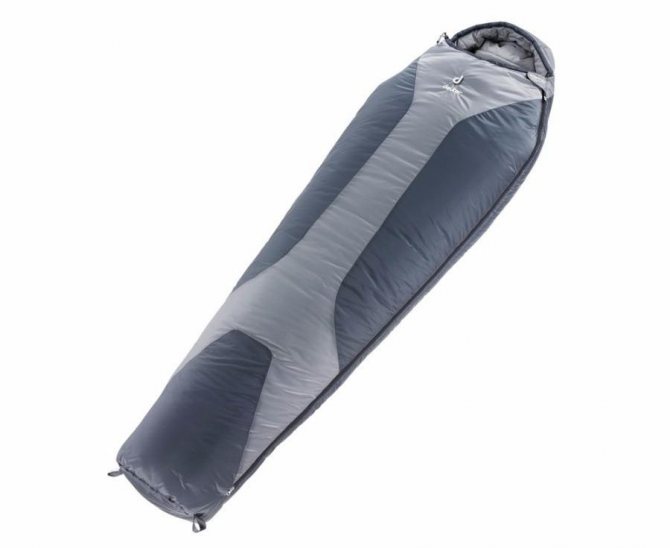
The 100-year experience behind the German company Deuter is an excellent guarantee of the quality of their tourism products. It’s not for nothing that many customers consider it the best manufacturer of sleeping bags with synthetic filling. And these are not unfounded allegations.
The top layer and lining of the Deuter Orbit -5 winter sleeping bag are made of advanced Pro Lite Soft material, which is quite durable and has successfully passed a number of wear resistance tests, in addition, it does not require special care and retains heat well. High Loft Hollowfibre is used as insulation, which not only warms, but is also designed for a long service life.
Classic cocoon shape with a zipper on the right or left side to choose from. The hood is deep and adjustable with comfortable double laces. The dimensions of the bag are 205*75*48 cm. In terms of heat conservation, it shows itself at a high level up to -5-7, the maximum possible limit for use is -23 degrees.
The price for a sleeping bag starts from 7,000 rubles.
Tramp Siberia 7000
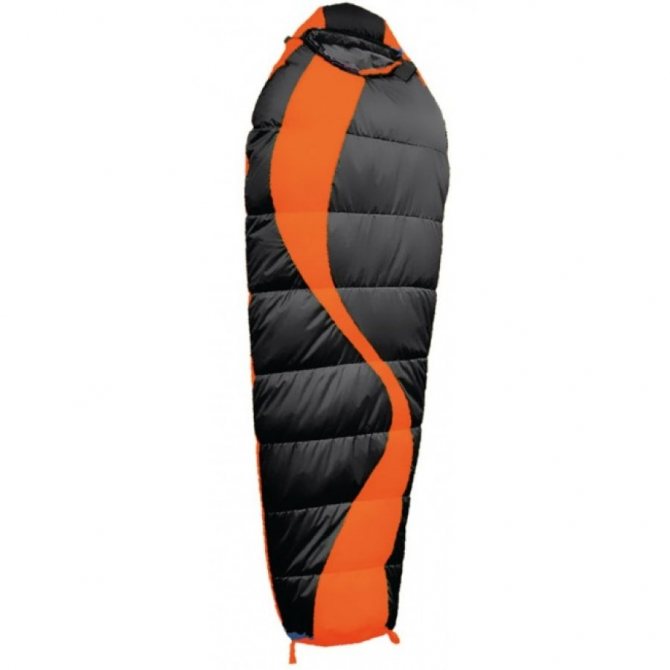
A budget and high-quality sleeping bag that can withstand temperatures down to -8, and reaches a maximum of -20. The outside is sewn from durable nylon taffeta fabric with moisture-proof impregnation, the lining is also nylon, only using reinforced thread. Filling: high-quality holofiber in two layers with a density of 500 g/sq.m.
Dimensions 230*80*55 cm, which is suitable even for a large person. The kit includes a compression bag for carrying and protection, but even when folded, the sleeping bag is quite large - 40*27 cm and weighs 2.3 kg.
Standard shape, double zipper with protective tape to prevent fabric from being bitten, secured at the head with a wide flap with Velcro. The hood is deep, allowing you to cover your entire face, leaving only a window for breathing.
Buyers praise the high strength of the fabric, which can withstand frequent use without complaints, good heat conservation and a comfortable body position in the sleeping bag. The only drawback is the large volume, which is uncomfortable to wear.
You can buy Tramp Siberia 7000 from 4,000 rubles.
